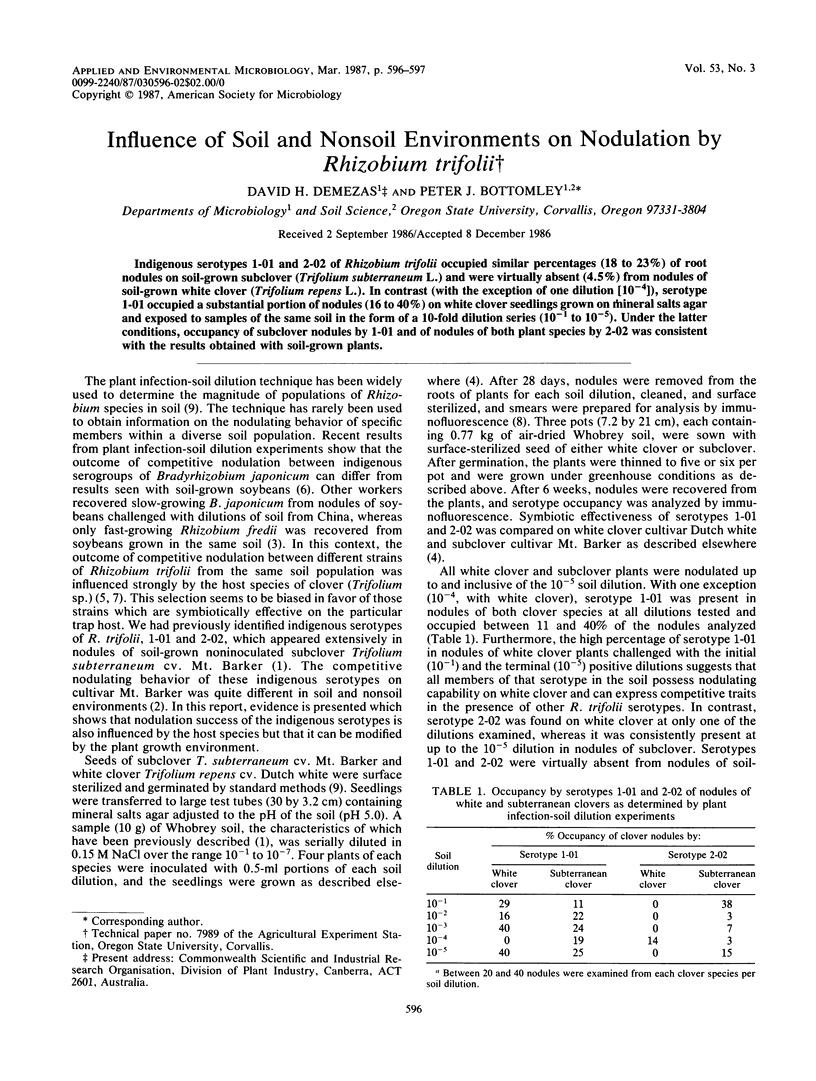Abstract
Indigenous serotypes 1-01 and 2-02 of Rhizobium trifolii occupied similar percentages (18 to 23%) of root nodules on soil-grown subclover (Trifolium subterraneum L.) and were virtually absent (4.5%) from nodules of soil-grown white clover (Trifolium repens L.). In contrast (with the exception of one dilution [10−4]), serotype 1-01 occupied a substantial portion of nodules (16 to 40%) on white clover seedlings grown on mineral salts agar and exposed to samples of the same soil in the form of a 10-fold dilution series (10−1 to 10−5). Under the latter conditions, occupancy of subclover nodules by 1-01 and of nodules of both plant species by 2-02 was consistent with the results obtained with soil-grown plants.
Full text
PDF

Selected References
These references are in PubMed. This may not be the complete list of references from this article.
- Demezas D. H., Bottomley P. J. Interstrain Competition between Representatives of Indigenous Serotypes of Rhizobium trifolii. Appl Environ Microbiol. 1986 Nov;52(5):1020–1025. doi: 10.1128/aem.52.5.1020-1025.1986. [DOI] [PMC free article] [PubMed] [Google Scholar]
- Dowdle S. F., Bohlool B. B. Predominance of Fast-Growing Rhizobium japonicum in a Soybean Field in the People's Republic of China. Appl Environ Microbiol. 1985 Nov;50(5):1171–1176. doi: 10.1128/aem.50.5.1171-1176.1985. [DOI] [PMC free article] [PubMed] [Google Scholar]
- Moawad H. A., Ellis W. R., Schmidt E. L. Rhizosphere Response as a Factor in Competition Among Three Serogroups of Indigenous Rhizobium japonicum for Nodulation of Field-Grown Soybeans. Appl Environ Microbiol. 1984 Apr;47(4):607–612. doi: 10.1128/aem.47.4.607-612.1984. [DOI] [PMC free article] [PubMed] [Google Scholar]
- Schmidt E. L., Bakole R. O., Bohlool B. B. Fluorescent-antibody approach to study of rhizobia in soil. J Bacteriol. 1968 Jun;95(6):1987–1992. doi: 10.1128/jb.95.6.1987-1992.1968. [DOI] [PMC free article] [PubMed] [Google Scholar]


